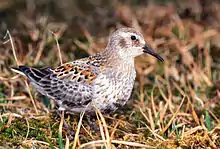Rock sandpiper
The rock sandpiper (Calidris or Erolia ptilocnemis) is a small shorebird.
| Rock sandpiper | |
|---|---|
 | |
| Scientific classification | |
| Kingdom: | Animalia |
| Phylum: | Chordata |
| Class: | Aves |
| Order: | Charadriiformes |
| Family: | Scolopacidae |
| Genus: | Calidris |
| Species: | C. ptilocnemis |
| Binomial name | |
| Calidris ptilocnemis Coues, 1873 | |
 | |
| Synonyms | |
|
Erolia ptilocnemis | |
Description

Adults have short yellow legs and a medium thin dark bill. The body is dark on top with a slight purplish gloss and mainly white underneath. The breast is smeared with grey and the rump is black. The Pribilof Islands subspecies of this bird shows a bold black belly patch.
Breeding
Their breeding habitat is the northern tundra on Arctic Pacific coast of Alaska and the Aleutian and Pribilof Islands. The birds also breed in Kamchatka and the Kuril Islands. The breeding pair is usually monogamous, with pair bonds usually lasting several years. They nest on the ground either elevated on rocks or in lower damp location. The males makes several scrapes; the female choose one and lays 4 eggs. Both the male and female take the responsibility for incubation.
Subspecies
There are four subspecies of rock sandpipers:
- C. p. tschuktschorum, (Portenko, 1937), breeds in Chukchi Peninsula and western Alaska.
- C. p. ptilocnemis, (Coues, 1873), breeds in the Pribilof Islands & on /Hall and St. Matthew Islands.
- C. p. couesi, (Ridgeway, 1880), breeds in the Aleutian Islands and on the Alaskan Peninsula.
- C. p. quarta, (Hartert, 1920), breeds on the south of the Kamchatka Peninsula and in the Kuril and Commander Islands.
Migration
Birds migrate south to rocky ice-free Pacific coasts in winter. The subspecies leap frog each other for winter, with more northerly breeders passing south of more southerly breeders. It can form rather large wintering flocks.
Rock Sandpipers which spend the non-breeding season in the Pacific Basin, Alaska, have to endure harsh conditions where they rely on high prey quality, especially of their primary prey - the bivalve Macoma balthica. [2]
Diet

These birds forage on rocky coasts. They mainly eat insects, mollusks, marine worms, also some plant material. It often feeds up to its breast in water, and often swims. It roosts on rocks near its feeding grounds just above the high tide spray.
References
| Wikimedia Commons has media related to Calidris ptilocnemis. |
| Wikispecies has information related to Calidris ptilocnemis. |
- BirdLife International (2012). "Calidris ptilocnemis". IUCN Red List of Threatened Species. 2012. Retrieved 26 November 2013.CS1 maint: ref=harv (link)
- Ruthrauff, D. R.; Dekinga, A.; Gill Jr, R. E.; Piersma, T. (2018). "Energetic solutions of Rock Sandpipers to harsh winter conditions rely on prey quality" (PDF). Ibis. 160 (2): 397–412. doi:10.1111/ibi.12534.

